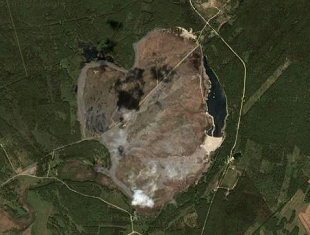
Written by Alan Bellows
In late 1945, along the banks of the Techa River in the Soviet Union, a dozen labor camps sent 70,000 inmates to begin construction of a secret city. Mere months earlier the United States' Little Boy and Fat Man bombs had flattened Hiroshima and Nagasaki, leaving Soviet leaders salivating over the massive power of the atom. In a rush to close the gap in weapons technology, the USSR commissioned a sprawling plutonium-production complex in the southern Ural mountains. The clandestine military-industrial community was to be operated by Russia's Mayak Chemical Combine, and it would come to be known as Chelyabinsk-40.
Within a few years the newfangled nuclear reactors were pumping out plutonium to fuel the Soviet Union's first atomic weapons. Chelyabinsk-40 was absent from all official maps, and it would be over forty years before the Soviet government would even acknowledge its existence. Nevertheless, the small city became an insidious influence in the Soviet Union, ultimately creating a corona of nuclear contamination dwarfing the devastation of the Chernobyl disaster.
By June 1948, after 31 months of brisk construction, the first of the Chelyabinsk-40 "breeder" reactors was brought online. Soon bricks of common uranium-238 were being bombarded with neutrons, resulting in loaves of pipin'-hot weapons-grade plutonium. In their haste to begin production, Soviet engineers lacked the time to establish proper waste-handling procedures, so most of the byproducts were dealt with by diluting them in water and squirting the effluent into the Techa River. The watered-down waste was a cocktail of "hot" elements, including long-lived fission products such as Strontium-90 and Cesium-137–each with a half-life of approximately thirty years.
In 1951, after about three years of operations at Chelyabinsk-40, Soviet scientists conducted a survey of the Techa River to determine whether radioactive contamination was becoming a problem. In the village of Metlino, just over four miles downriver from the plutonium plant, investigators and Geiger counters clicked nervously along the river bank. Rather than the typical "background" gamma radiation of about 0.21 Röntgens per year, the edge of the Techa River was emanating 5 Röntgens per hour. Such elevated levels were rather distressing since that the river was the primary source of water for the 1,200 residents there. Subsequent measurements found extensive contamination in 38 other villages along the Techa, seriously jeopardizing the health of about 28,000 people. In addition, almost 100,000 other residents were being exposed to elevated-but-not-quite-as-deadly doses of gamma radiation, both from the river itself and from the floodplain where crops and livestock were raised.
In an effort to avoid serious radiological health effects among the populace, the Soviet government relocated about 7,500 villagers from the most heavily contaminated areas, fenced off the floodplain, and dug wells to provide an alternate water source for the remaining villages. Engineers were brought in to erect earthen dams along the Techa River to prevent radioactive sediments from migrating further downstream. The Soviet scientists at Chelyabinsk-40 also revised their waste disposal strategy, halting the practice of dumping effluent directly into the river. Instead, they constructed a set of "intermediate storage tanks" where waste water could spend some time bleeding off radioactivity. After lingering in these vats for a few months, the diluted dregs were periodically piped to the new long-term storage location: a ten-foot-deep, 110 acre lake called Karachay. For a while these measures spared the Techa River residents from further increases in exposure, but the Mayak Chemical Combine had only begun to demonstrate its flair for misfortune.
By the mid 1950s the workers at the plutonium production plant began to complain of soreness, low blood pressure, loss of coordination, and tremors–the classic symptoms of chronic radiation syndrome. The facility itself was also beginning to encounter chronic complications, particularly in the new intermediate storage system. The row of waste vats sat in a concrete canal a few kilometers outside the main complex, submerged in a constant flow of water to carry away the heat generated by radioactive decay. Soon the technicians discovered that the hot isotopes in the waste water tended to cause a bit of evaporation inside the tanks, resulting in more buoyancy than had been anticipated. This upward pressure put stress on the inlet pipes, eventually compromising the seals and allowing raw radioactive waste to seep into the canal's coolant water. To make matters worse, several of the tanks' heat exchangers failed, crippling their cooling capacity.
The workers were aware of these faults, but the ambient radiation in the cooling trench forestalled any repairs. A flurry of calculations indicated that most of the waste water in the tanks would remain in a stable liquid state even without the additional cooling, so technicians continued to operate the plutonium plant in spite of these problems. Their evaporation calculations were in error, however, and the water inside the defective tanks gradually boiled away. A radioactive sludge of nitrates and acetates was left behind, a chemical compound roughly equivalent to TNT.
Unable to shed much heat, the concentrated radioactive slurry continued to increase in temperature within the defective 80,000 gallon containers. On 29 September 1957, one tank reached an estimated 660 degrees Fahrenheit. At 4:20pm local time, the explosive salt deposits in the bottom of the vat detonated. The blast ignited the contents of the other dried-out tanks, producing a combined explosive force equivalent to about 85 tons of TNT. The thick concrete lid which covered the cooling trench was hurled eighty feet away, and seventy tons of highly radioactive fission products were ejected into the open atmosphere. The buildings at Chelyabinsk-40 shuddered as they were buffeted by the shock wave.
While investigators probed the blast site in protective suits, a mile-high column of radionuclides dragged across the landscape. The gamma-emitting dust cloud spread hazardous isotopes of cesium and strontium over 9,000 square miles, affecting some 270,000 Soviet citizens and their food supplies. Over twenty megacuries (MCi) of radioactivity were released, almost half of that expelled by the Chernobyl incident.
In the days that followed, strange reports began to emerge from downwind villages. According to author Richard Pollock in a 1978 Critical Mass Journal article, residents of the Chelyabinsk Province became "hysterical with fear with the incidence of unknown 'mysterious' diseases breaking out. Victims were seen with skin 'sloughing off' their faces, hands and other exposed parts of their bodies." After the customary ten-day period of hand-sitting, the government ordered the evacuation of many villages where skin-sloughers and blood-vomiters had appeared. This mass migration left the landscape littered with radioactive ghost towns.
The facilities at Chelyabinsk-40 were swiftly decontaminated with hoses, mops, and squeegees, and soon plutonium production was underway again. The intermediate storage system had been partially compromised by the accident, but the factory was still able to squirt its constant flow of radioactive effluence into Lake Karachay. The lake lacked any surface outlets, so optimistic engineers reasoned that anything dumped into the lake would remain entombed there indefinitely.
Many locals were hospitalized with radiation poisoning in the weeks after the waste-tank blast, but the Soviet state forbade doctors from disclosing the true nature of the illnesses. Instead, physicians were instructed to diagnose sufferers with ambiguous "blood problems" and "vegetative syndromes." The Russian government likewise withheld the colossal calamity from the international community. Within two years, the radiation killed all of the pine trees within a twelve mile radius of Chelyabinsk-40. Highway signs were erected at the edges of the contaminated zone, imploring travelers to roll up their windows while traversing the deteriorated swath of Earth, and to not stop for any reason.
Ten years later, in 1967, a severe drought struck the Chelyabinsk Province. Much to the Russian scientists' alarm, shallow Lake Karachay gradually began to shrink from its shores. Over several months the water dwindled considerably, leaving the lake about half-empty (or half-full, if you're more upbeat). This exposed the radioactive sediment in the lake basin, and fifteen years' worth of radionuclides took to the breeze. About 900 square miles of land was peppered with Strontium-90, Cesium-137, and other unhealthy elements. Almost half a million residents were in the path of this latest dust cloud of doom, many of them the same people who had been affected by the 1957 waste-tank explosion.
Soviet engineers hastily enacted a program to help prevent further sediment from leaving Lake Karachay. For a dozen or so years they dumped rocks, soil, and large concrete blocks into the tainted basin. The Mayak Chemical Combine conceded that the lake was an inadequate long-term storage system, and ordered that Karachay be slowly sealed in a shell of earth and concrete.
In 1990, as the Soviet Union teetered at the brink of collapse, government officials finally acknowledged the existence of the secret city of Chelyabinsk-40 (soon renamed to Chelyabinsk-65, then later changed to Ozersk). They also acknowledged its tragic parade of radiological disasters. At that time Lake Karachay remained as the principal waste-dumping site for for the plutonium plant, but the effort to fill the lake with soil and concrete had halved its surface area.
Thirty-nine years of effluent had saturated the lake with nasty isotopes, including an estimated 120 megacuries of long-lived radiation. In contrast, the Chernobyl incident released roughly 100 megacuries of radiation into the environment, but only about 3 megacuries of Strontium-90 and Cesium-137. A delegation who visited Lake Karachay in 1990 measured the radiation at the point where the effluent entered the water, and the needles of their Geiger counters danced at about 600 Röntgens per hour–enough to provide a lethal dose in one hour. They did not linger long.
A report compiled in 1991 found that the incidence of leukemia in the region had increased by 41% since Chelyabinsk-40 opened for business, and that during the 1980s cancers had increased by 21% and circulatory disorders rose by 31%. It is probable, however, that the true numbers are much higher since doctors were required to limit the number diagnoses issued for cancer and other radiation-related illnesses. In the village of Muslyumovo, a local physician's personal records from 1993 indicated an average male lifespan of 45 years compared to 69 in the rest of the country. Birth defects, sterility, and chronic disease also increased dramatically. In all, over a million Russian citizens were directly affected by the misadventures of the Mayak Chemical Combine from 1948 to 1990, including around 28,000 people classified as "seriously irradiated."
Today, there are huge tracts of Chelyabinsk land still uninhabitable due to the radionuclides from the river contamination, the 1957 blast, and the 1967 drought. The surface of Lake Karachay is now made up of more concrete than water, however the lake's payload of fission products is not completely captive. Recent surveys have detected gamma-emitting elements in nearby rivers, indicating that undesirable isotopes have been seeping into the water table. Estimates suggest that approximately a billion gallons of groundwater have already been contaminated with 5 megacuries of radionuclides. The neighboring Norwegians are understandably nervous that some of the pollution could find its way into their water supply, or even into the Arctic Ocean.
Russia has long been fond of producing the most massive specimens of military might: the monstrous Tsar Cannon, the 200-ton Tsar Bell, the cumbersome Tsar Tank, and the 50-megaton Tsar Bomba. In that "biggest-ever" tradition, the Mayak Chemical Combine is now credited by the Worldwatch Institute as the creator of the "most polluted spot" in history, a mess whose true magnitude is yet to be known.




















